Color Affect an Individual's Mood
VerifiedAdded on 2023/01/16
|18
|4029
|20
AI Summary
This research paper explores the impact of color on an individual's mood and behavior. It discusses how colors can alter emotions and create different moods. The study includes a literature review, a survey, and data analysis using SPSS. The findings provide insights into the psychological aspect of colors and their use in enhancing mood.
Contribute Materials
Your contribution can guide someone’s learning journey. Share your
documents today.
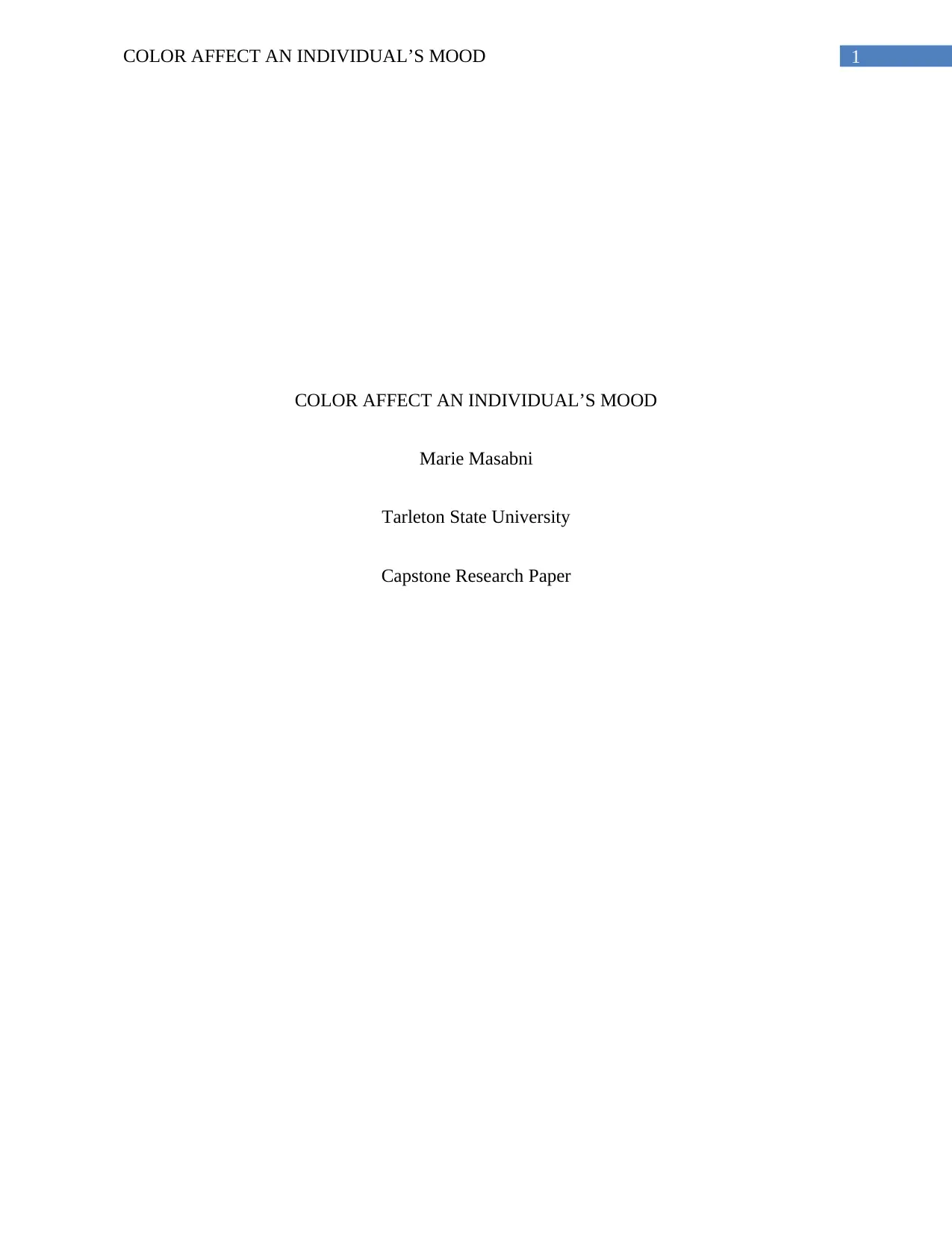
1COLOR AFFECT AN INDIVIDUAL’S MOOD
COLOR AFFECT AN INDIVIDUAL’S MOOD
Marie Masabni
Tarleton State University
Capstone Research Paper
COLOR AFFECT AN INDIVIDUAL’S MOOD
Marie Masabni
Tarleton State University
Capstone Research Paper
Secure Best Marks with AI Grader
Need help grading? Try our AI Grader for instant feedback on your assignments.
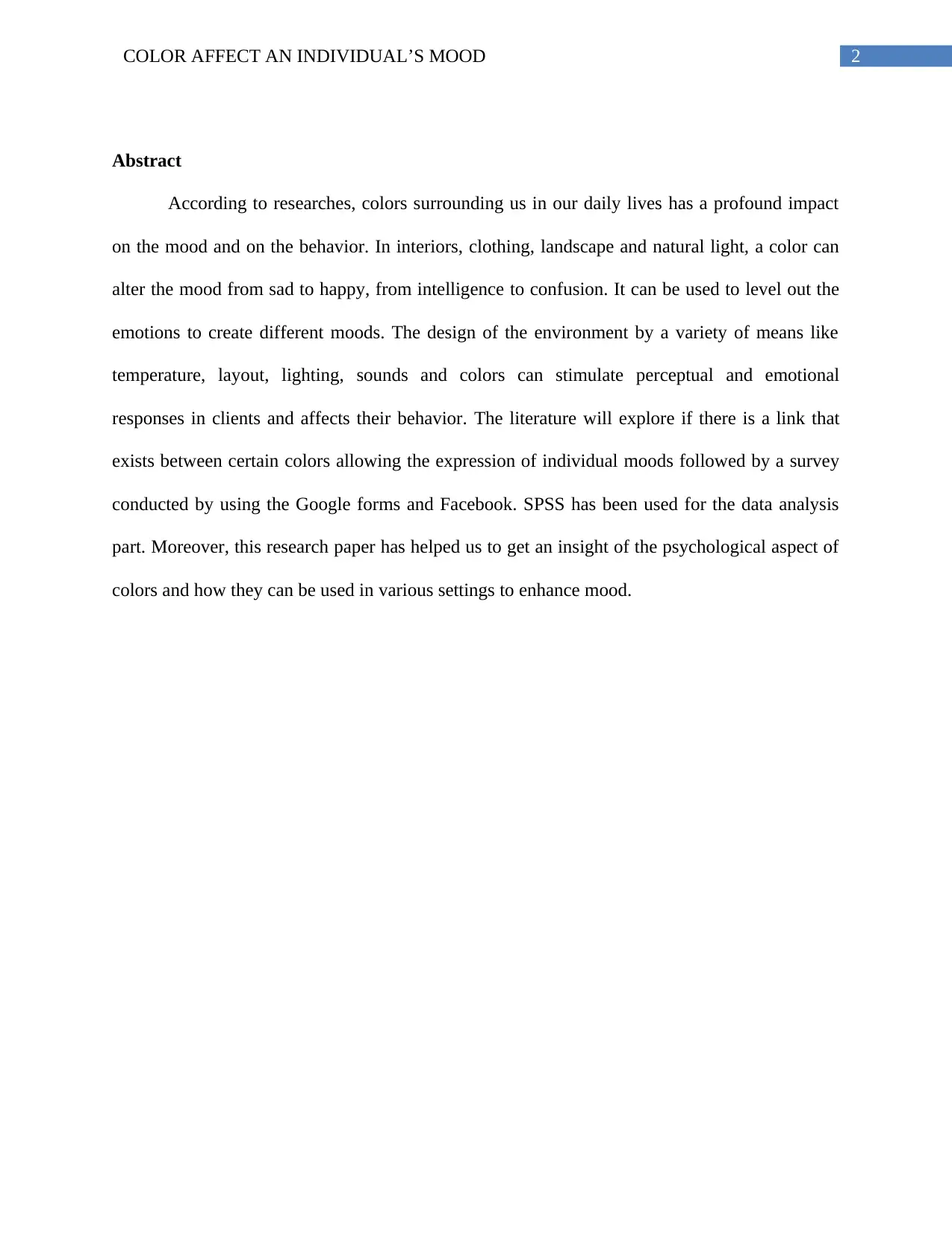
2COLOR AFFECT AN INDIVIDUAL’S MOOD
Abstract
According to researches, colors surrounding us in our daily lives has a profound impact
on the mood and on the behavior. In interiors, clothing, landscape and natural light, a color can
alter the mood from sad to happy, from intelligence to confusion. It can be used to level out the
emotions to create different moods. The design of the environment by a variety of means like
temperature, layout, lighting, sounds and colors can stimulate perceptual and emotional
responses in clients and affects their behavior. The literature will explore if there is a link that
exists between certain colors allowing the expression of individual moods followed by a survey
conducted by using the Google forms and Facebook. SPSS has been used for the data analysis
part. Moreover, this research paper has helped us to get an insight of the psychological aspect of
colors and how they can be used in various settings to enhance mood.
Abstract
According to researches, colors surrounding us in our daily lives has a profound impact
on the mood and on the behavior. In interiors, clothing, landscape and natural light, a color can
alter the mood from sad to happy, from intelligence to confusion. It can be used to level out the
emotions to create different moods. The design of the environment by a variety of means like
temperature, layout, lighting, sounds and colors can stimulate perceptual and emotional
responses in clients and affects their behavior. The literature will explore if there is a link that
exists between certain colors allowing the expression of individual moods followed by a survey
conducted by using the Google forms and Facebook. SPSS has been used for the data analysis
part. Moreover, this research paper has helped us to get an insight of the psychological aspect of
colors and how they can be used in various settings to enhance mood.
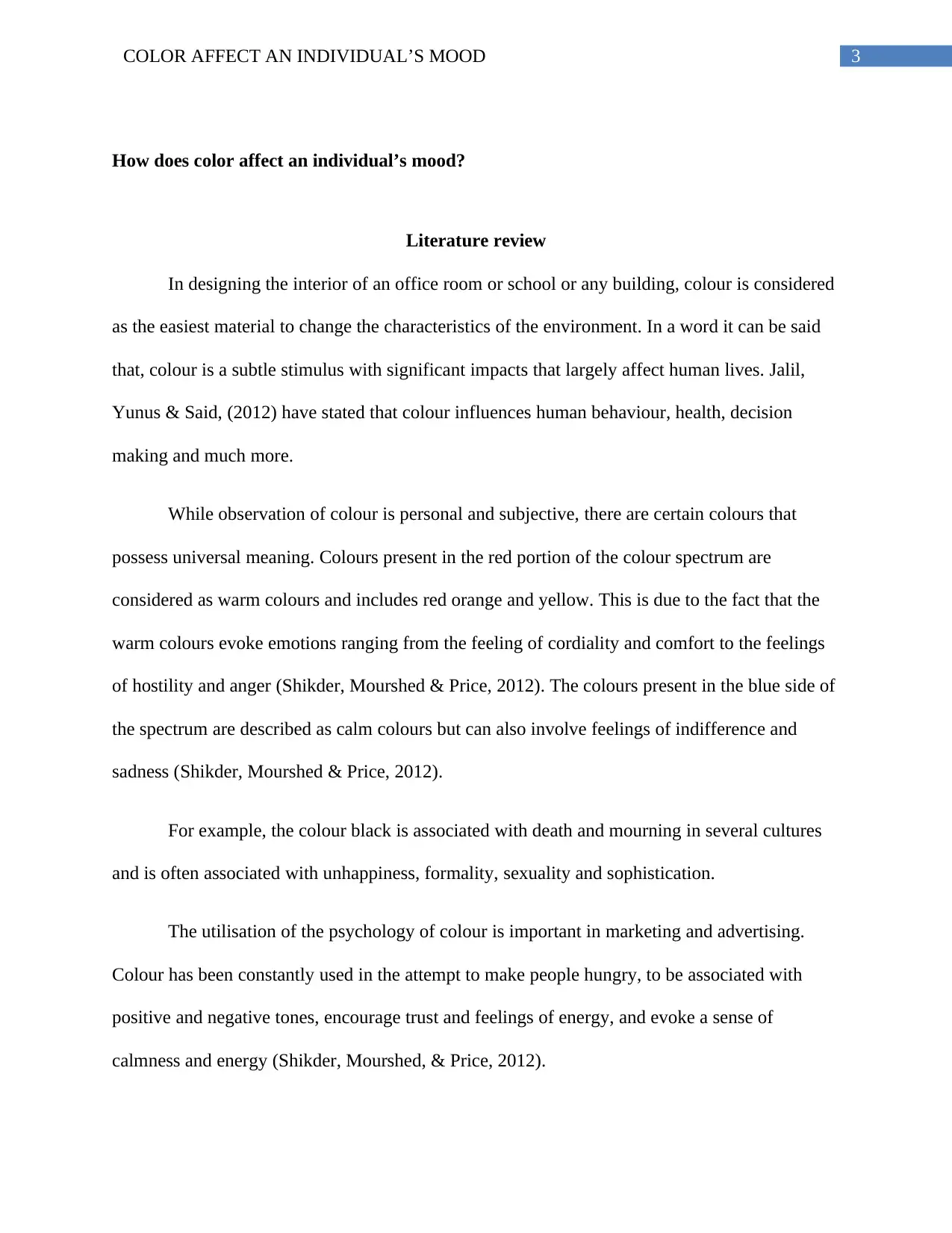
3COLOR AFFECT AN INDIVIDUAL’S MOOD
How does color affect an individual’s mood?
Literature review
In designing the interior of an office room or school or any building, colour is considered
as the easiest material to change the characteristics of the environment. In a word it can be said
that, colour is a subtle stimulus with significant impacts that largely affect human lives. Jalil,
Yunus & Said, (2012) have stated that colour influences human behaviour, health, decision
making and much more.
While observation of colour is personal and subjective, there are certain colours that
possess universal meaning. Colours present in the red portion of the colour spectrum are
considered as warm colours and includes red orange and yellow. This is due to the fact that the
warm colours evoke emotions ranging from the feeling of cordiality and comfort to the feelings
of hostility and anger (Shikder, Mourshed & Price, 2012). The colours present in the blue side of
the spectrum are described as calm colours but can also involve feelings of indifference and
sadness (Shikder, Mourshed & Price, 2012).
For example, the colour black is associated with death and mourning in several cultures
and is often associated with unhappiness, formality, sexuality and sophistication.
The utilisation of the psychology of colour is important in marketing and advertising.
Colour has been constantly used in the attempt to make people hungry, to be associated with
positive and negative tones, encourage trust and feelings of energy, and evoke a sense of
calmness and energy (Shikder, Mourshed, & Price, 2012).
How does color affect an individual’s mood?
Literature review
In designing the interior of an office room or school or any building, colour is considered
as the easiest material to change the characteristics of the environment. In a word it can be said
that, colour is a subtle stimulus with significant impacts that largely affect human lives. Jalil,
Yunus & Said, (2012) have stated that colour influences human behaviour, health, decision
making and much more.
While observation of colour is personal and subjective, there are certain colours that
possess universal meaning. Colours present in the red portion of the colour spectrum are
considered as warm colours and includes red orange and yellow. This is due to the fact that the
warm colours evoke emotions ranging from the feeling of cordiality and comfort to the feelings
of hostility and anger (Shikder, Mourshed & Price, 2012). The colours present in the blue side of
the spectrum are described as calm colours but can also involve feelings of indifference and
sadness (Shikder, Mourshed & Price, 2012).
For example, the colour black is associated with death and mourning in several cultures
and is often associated with unhappiness, formality, sexuality and sophistication.
The utilisation of the psychology of colour is important in marketing and advertising.
Colour has been constantly used in the attempt to make people hungry, to be associated with
positive and negative tones, encourage trust and feelings of energy, and evoke a sense of
calmness and energy (Shikder, Mourshed, & Price, 2012).
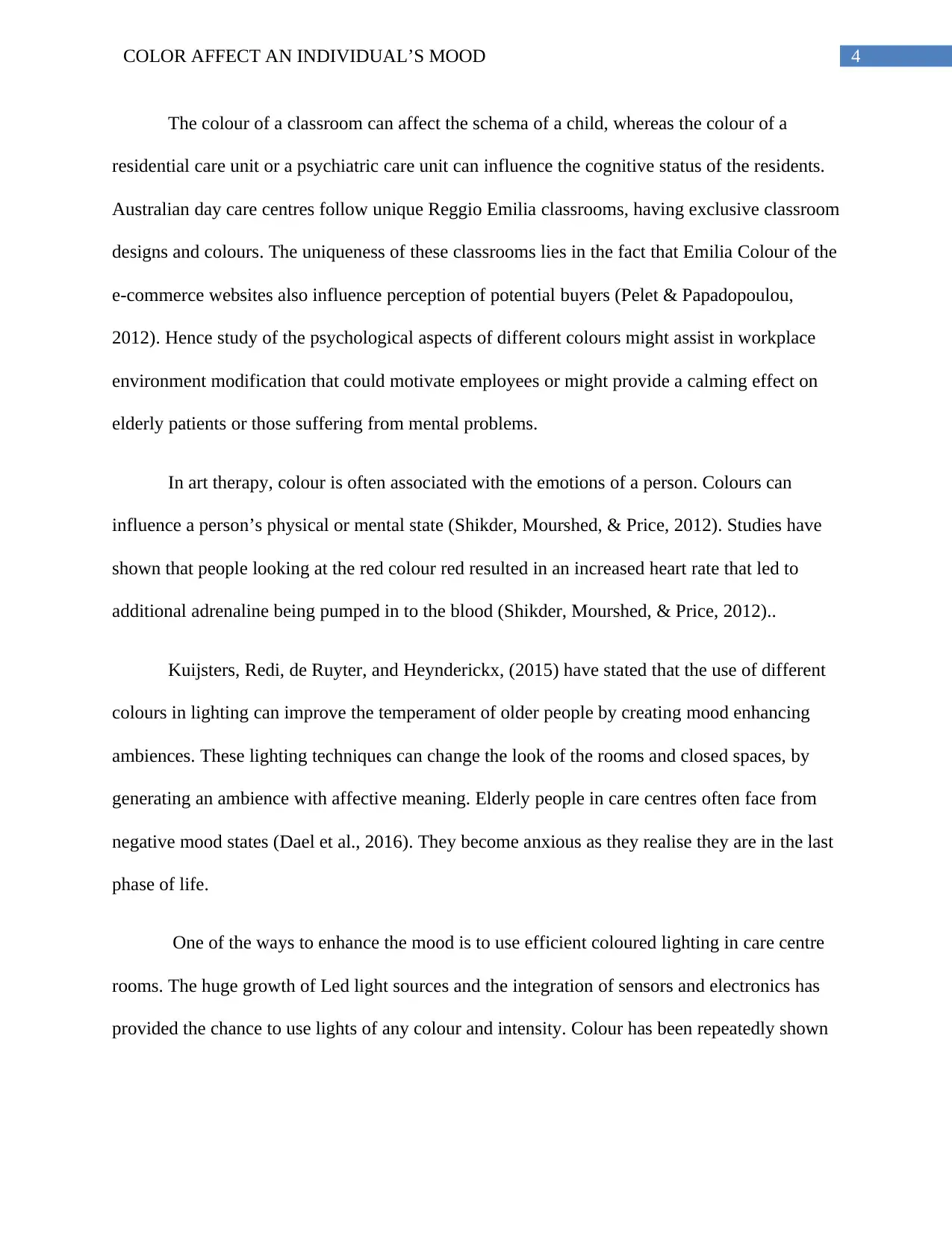
4COLOR AFFECT AN INDIVIDUAL’S MOOD
The colour of a classroom can affect the schema of a child, whereas the colour of a
residential care unit or a psychiatric care unit can influence the cognitive status of the residents.
Australian day care centres follow unique Reggio Emilia classrooms, having exclusive classroom
designs and colours. The uniqueness of these classrooms lies in the fact that Emilia Colour of the
e-commerce websites also influence perception of potential buyers (Pelet & Papadopoulou,
2012). Hence study of the psychological aspects of different colours might assist in workplace
environment modification that could motivate employees or might provide a calming effect on
elderly patients or those suffering from mental problems.
In art therapy, colour is often associated with the emotions of a person. Colours can
influence a person’s physical or mental state (Shikder, Mourshed, & Price, 2012). Studies have
shown that people looking at the red colour red resulted in an increased heart rate that led to
additional adrenaline being pumped in to the blood (Shikder, Mourshed, & Price, 2012)..
Kuijsters, Redi, de Ruyter, and Heynderickx, (2015) have stated that the use of different
colours in lighting can improve the temperament of older people by creating mood enhancing
ambiences. These lighting techniques can change the look of the rooms and closed spaces, by
generating an ambience with affective meaning. Elderly people in care centres often face from
negative mood states (Dael et al., 2016). They become anxious as they realise they are in the last
phase of life.
One of the ways to enhance the mood is to use efficient coloured lighting in care centre
rooms. The huge growth of Led light sources and the integration of sensors and electronics has
provided the chance to use lights of any colour and intensity. Colour has been repeatedly shown
The colour of a classroom can affect the schema of a child, whereas the colour of a
residential care unit or a psychiatric care unit can influence the cognitive status of the residents.
Australian day care centres follow unique Reggio Emilia classrooms, having exclusive classroom
designs and colours. The uniqueness of these classrooms lies in the fact that Emilia Colour of the
e-commerce websites also influence perception of potential buyers (Pelet & Papadopoulou,
2012). Hence study of the psychological aspects of different colours might assist in workplace
environment modification that could motivate employees or might provide a calming effect on
elderly patients or those suffering from mental problems.
In art therapy, colour is often associated with the emotions of a person. Colours can
influence a person’s physical or mental state (Shikder, Mourshed, & Price, 2012). Studies have
shown that people looking at the red colour red resulted in an increased heart rate that led to
additional adrenaline being pumped in to the blood (Shikder, Mourshed, & Price, 2012)..
Kuijsters, Redi, de Ruyter, and Heynderickx, (2015) have stated that the use of different
colours in lighting can improve the temperament of older people by creating mood enhancing
ambiences. These lighting techniques can change the look of the rooms and closed spaces, by
generating an ambience with affective meaning. Elderly people in care centres often face from
negative mood states (Dael et al., 2016). They become anxious as they realise they are in the last
phase of life.
One of the ways to enhance the mood is to use efficient coloured lighting in care centre
rooms. The huge growth of Led light sources and the integration of sensors and electronics has
provided the chance to use lights of any colour and intensity. Colour has been repeatedly shown
Secure Best Marks with AI Grader
Need help grading? Try our AI Grader for instant feedback on your assignments.
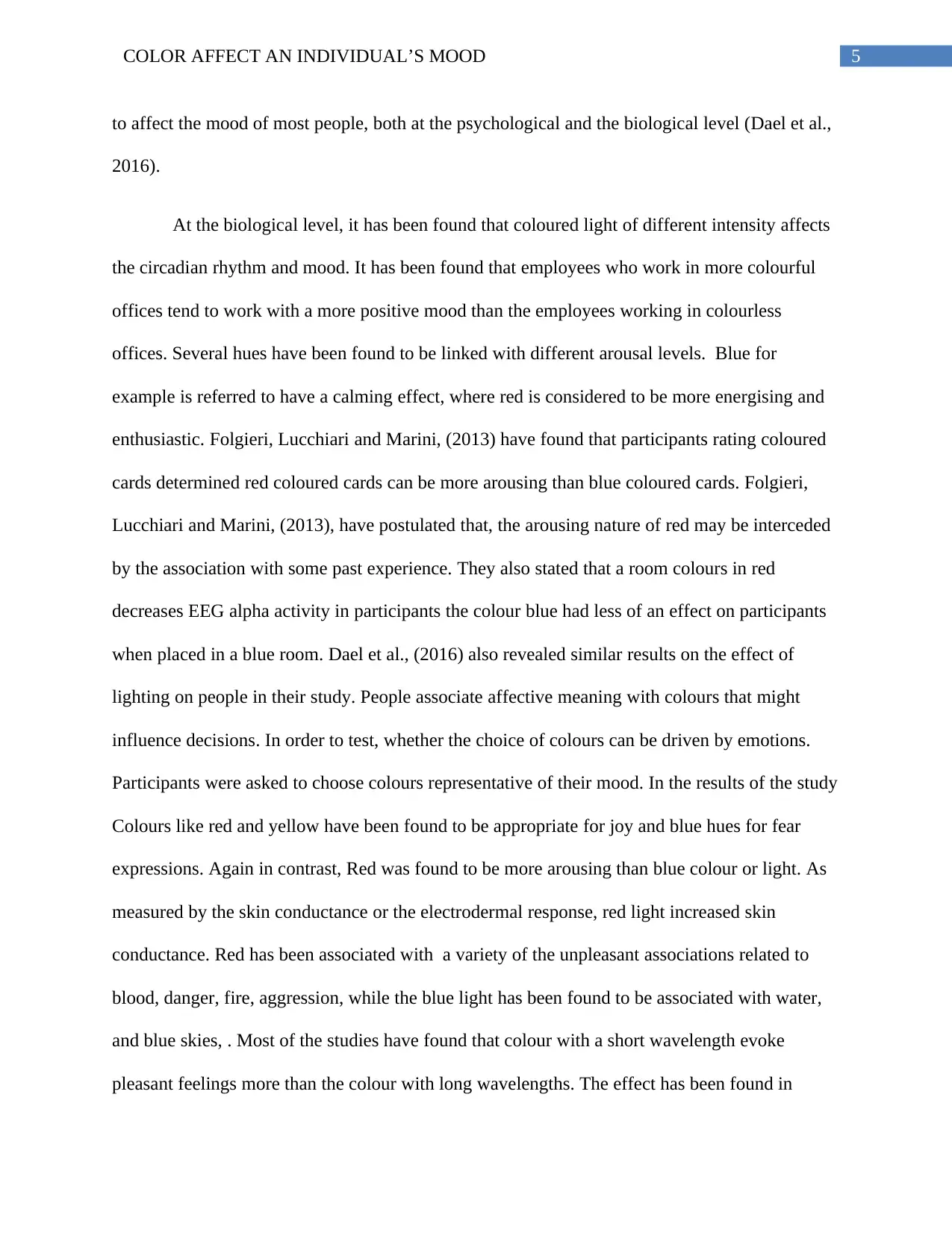
5COLOR AFFECT AN INDIVIDUAL’S MOOD
to affect the mood of most people, both at the psychological and the biological level (Dael et al.,
2016).
At the biological level, it has been found that coloured light of different intensity affects
the circadian rhythm and mood. It has been found that employees who work in more colourful
offices tend to work with a more positive mood than the employees working in colourless
offices. Several hues have been found to be linked with different arousal levels. Blue for
example is referred to have a calming effect, where red is considered to be more energising and
enthusiastic. Folgieri, Lucchiari and Marini, (2013) have found that participants rating coloured
cards determined red coloured cards can be more arousing than blue coloured cards. Folgieri,
Lucchiari and Marini, (2013), have postulated that, the arousing nature of red may be interceded
by the association with some past experience. They also stated that a room colours in red
decreases EEG alpha activity in participants the colour blue had less of an effect on participants
when placed in a blue room. Dael et al., (2016) also revealed similar results on the effect of
lighting on people in their study. People associate affective meaning with colours that might
influence decisions. In order to test, whether the choice of colours can be driven by emotions.
Participants were asked to choose colours representative of their mood. In the results of the study
Colours like red and yellow have been found to be appropriate for joy and blue hues for fear
expressions. Again in contrast, Red was found to be more arousing than blue colour or light. As
measured by the skin conductance or the electrodermal response, red light increased skin
conductance. Red has been associated with a variety of the unpleasant associations related to
blood, danger, fire, aggression, while the blue light has been found to be associated with water,
and blue skies, . Most of the studies have found that colour with a short wavelength evoke
pleasant feelings more than the colour with long wavelengths. The effect has been found in
to affect the mood of most people, both at the psychological and the biological level (Dael et al.,
2016).
At the biological level, it has been found that coloured light of different intensity affects
the circadian rhythm and mood. It has been found that employees who work in more colourful
offices tend to work with a more positive mood than the employees working in colourless
offices. Several hues have been found to be linked with different arousal levels. Blue for
example is referred to have a calming effect, where red is considered to be more energising and
enthusiastic. Folgieri, Lucchiari and Marini, (2013) have found that participants rating coloured
cards determined red coloured cards can be more arousing than blue coloured cards. Folgieri,
Lucchiari and Marini, (2013), have postulated that, the arousing nature of red may be interceded
by the association with some past experience. They also stated that a room colours in red
decreases EEG alpha activity in participants the colour blue had less of an effect on participants
when placed in a blue room. Dael et al., (2016) also revealed similar results on the effect of
lighting on people in their study. People associate affective meaning with colours that might
influence decisions. In order to test, whether the choice of colours can be driven by emotions.
Participants were asked to choose colours representative of their mood. In the results of the study
Colours like red and yellow have been found to be appropriate for joy and blue hues for fear
expressions. Again in contrast, Red was found to be more arousing than blue colour or light. As
measured by the skin conductance or the electrodermal response, red light increased skin
conductance. Red has been associated with a variety of the unpleasant associations related to
blood, danger, fire, aggression, while the blue light has been found to be associated with water,
and blue skies, . Most of the studies have found that colour with a short wavelength evoke
pleasant feelings more than the colour with long wavelengths. The effect has been found in
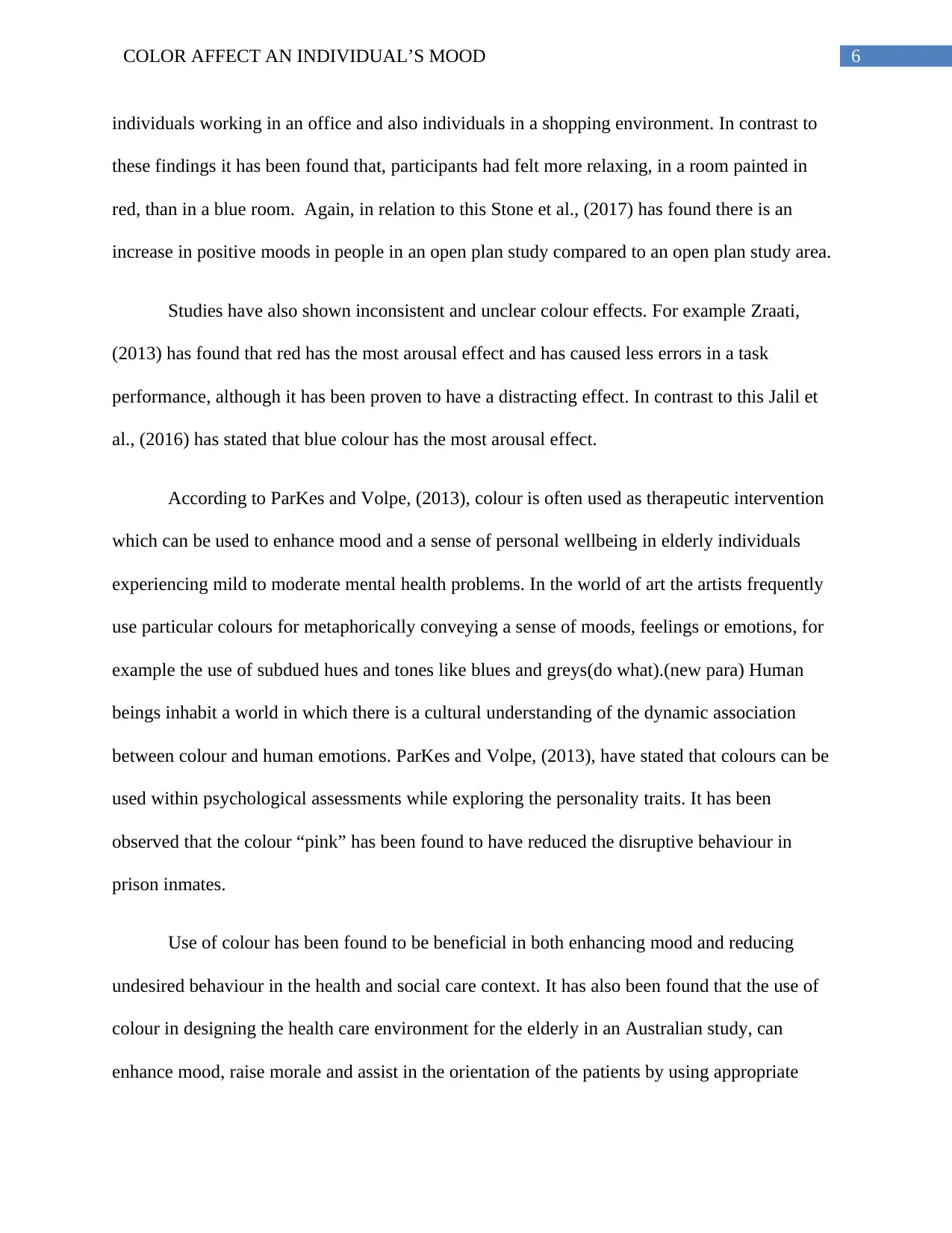
6COLOR AFFECT AN INDIVIDUAL’S MOOD
individuals working in an office and also individuals in a shopping environment. In contrast to
these findings it has been found that, participants had felt more relaxing, in a room painted in
red, than in a blue room. Again, in relation to this Stone et al., (2017) has found there is an
increase in positive moods in people in an open plan study compared to an open plan study area.
Studies have also shown inconsistent and unclear colour effects. For example Zraati,
(2013) has found that red has the most arousal effect and has caused less errors in a task
performance, although it has been proven to have a distracting effect. In contrast to this Jalil et
al., (2016) has stated that blue colour has the most arousal effect.
According to ParKes and Volpe, (2013), colour is often used as therapeutic intervention
which can be used to enhance mood and a sense of personal wellbeing in elderly individuals
experiencing mild to moderate mental health problems. In the world of art the artists frequently
use particular colours for metaphorically conveying a sense of moods, feelings or emotions, for
example the use of subdued hues and tones like blues and greys(do what).(new para) Human
beings inhabit a world in which there is a cultural understanding of the dynamic association
between colour and human emotions. ParKes and Volpe, (2013), have stated that colours can be
used within psychological assessments while exploring the personality traits. It has been
observed that the colour “pink” has been found to have reduced the disruptive behaviour in
prison inmates.
Use of colour has been found to be beneficial in both enhancing mood and reducing
undesired behaviour in the health and social care context. It has also been found that the use of
colour in designing the health care environment for the elderly in an Australian study, can
enhance mood, raise morale and assist in the orientation of the patients by using appropriate
individuals working in an office and also individuals in a shopping environment. In contrast to
these findings it has been found that, participants had felt more relaxing, in a room painted in
red, than in a blue room. Again, in relation to this Stone et al., (2017) has found there is an
increase in positive moods in people in an open plan study compared to an open plan study area.
Studies have also shown inconsistent and unclear colour effects. For example Zraati,
(2013) has found that red has the most arousal effect and has caused less errors in a task
performance, although it has been proven to have a distracting effect. In contrast to this Jalil et
al., (2016) has stated that blue colour has the most arousal effect.
According to ParKes and Volpe, (2013), colour is often used as therapeutic intervention
which can be used to enhance mood and a sense of personal wellbeing in elderly individuals
experiencing mild to moderate mental health problems. In the world of art the artists frequently
use particular colours for metaphorically conveying a sense of moods, feelings or emotions, for
example the use of subdued hues and tones like blues and greys(do what).(new para) Human
beings inhabit a world in which there is a cultural understanding of the dynamic association
between colour and human emotions. ParKes and Volpe, (2013), have stated that colours can be
used within psychological assessments while exploring the personality traits. It has been
observed that the colour “pink” has been found to have reduced the disruptive behaviour in
prison inmates.
Use of colour has been found to be beneficial in both enhancing mood and reducing
undesired behaviour in the health and social care context. It has also been found that the use of
colour in designing the health care environment for the elderly in an Australian study, can
enhance mood, raise morale and assist in the orientation of the patients by using appropriate
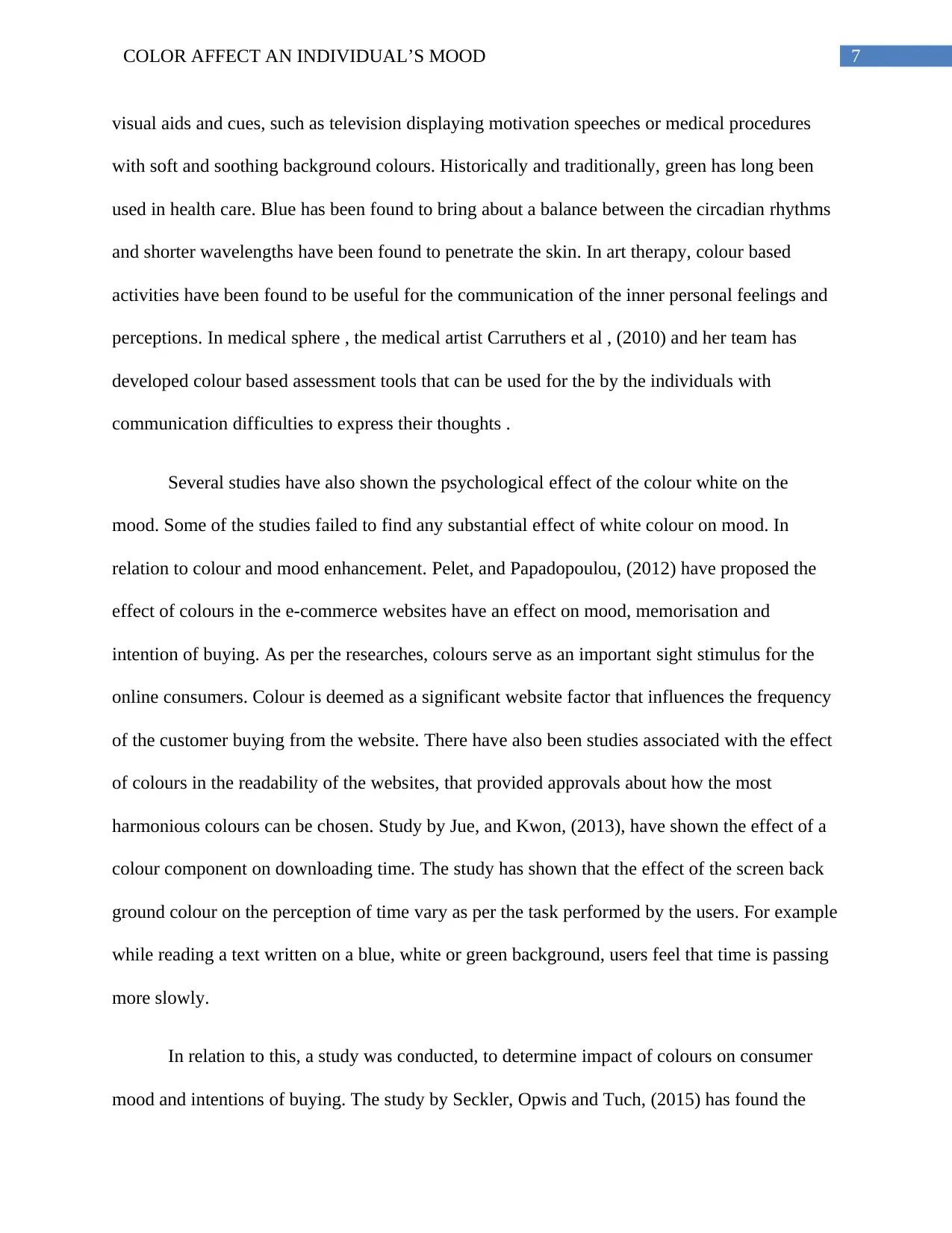
7COLOR AFFECT AN INDIVIDUAL’S MOOD
visual aids and cues, such as television displaying motivation speeches or medical procedures
with soft and soothing background colours. Historically and traditionally, green has long been
used in health care. Blue has been found to bring about a balance between the circadian rhythms
and shorter wavelengths have been found to penetrate the skin. In art therapy, colour based
activities have been found to be useful for the communication of the inner personal feelings and
perceptions. In medical sphere , the medical artist Carruthers et al , (2010) and her team has
developed colour based assessment tools that can be used for the by the individuals with
communication difficulties to express their thoughts .
Several studies have also shown the psychological effect of the colour white on the
mood. Some of the studies failed to find any substantial effect of white colour on mood. In
relation to colour and mood enhancement. Pelet, and Papadopoulou, (2012) have proposed the
effect of colours in the e-commerce websites have an effect on mood, memorisation and
intention of buying. As per the researches, colours serve as an important sight stimulus for the
online consumers. Colour is deemed as a significant website factor that influences the frequency
of the customer buying from the website. There have also been studies associated with the effect
of colours in the readability of the websites, that provided approvals about how the most
harmonious colours can be chosen. Study by Jue, and Kwon, (2013), have shown the effect of a
colour component on downloading time. The study has shown that the effect of the screen back
ground colour on the perception of time vary as per the task performed by the users. For example
while reading a text written on a blue, white or green background, users feel that time is passing
more slowly.
In relation to this, a study was conducted, to determine impact of colours on consumer
mood and intentions of buying. The study by Seckler, Opwis and Tuch, (2015) has found the
visual aids and cues, such as television displaying motivation speeches or medical procedures
with soft and soothing background colours. Historically and traditionally, green has long been
used in health care. Blue has been found to bring about a balance between the circadian rhythms
and shorter wavelengths have been found to penetrate the skin. In art therapy, colour based
activities have been found to be useful for the communication of the inner personal feelings and
perceptions. In medical sphere , the medical artist Carruthers et al , (2010) and her team has
developed colour based assessment tools that can be used for the by the individuals with
communication difficulties to express their thoughts .
Several studies have also shown the psychological effect of the colour white on the
mood. Some of the studies failed to find any substantial effect of white colour on mood. In
relation to colour and mood enhancement. Pelet, and Papadopoulou, (2012) have proposed the
effect of colours in the e-commerce websites have an effect on mood, memorisation and
intention of buying. As per the researches, colours serve as an important sight stimulus for the
online consumers. Colour is deemed as a significant website factor that influences the frequency
of the customer buying from the website. There have also been studies associated with the effect
of colours in the readability of the websites, that provided approvals about how the most
harmonious colours can be chosen. Study by Jue, and Kwon, (2013), have shown the effect of a
colour component on downloading time. The study has shown that the effect of the screen back
ground colour on the perception of time vary as per the task performed by the users. For example
while reading a text written on a blue, white or green background, users feel that time is passing
more slowly.
In relation to this, a study was conducted, to determine impact of colours on consumer
mood and intentions of buying. The study by Seckler, Opwis and Tuch, (2015) has found the
Paraphrase This Document
Need a fresh take? Get an instant paraphrase of this document with our AI Paraphraser
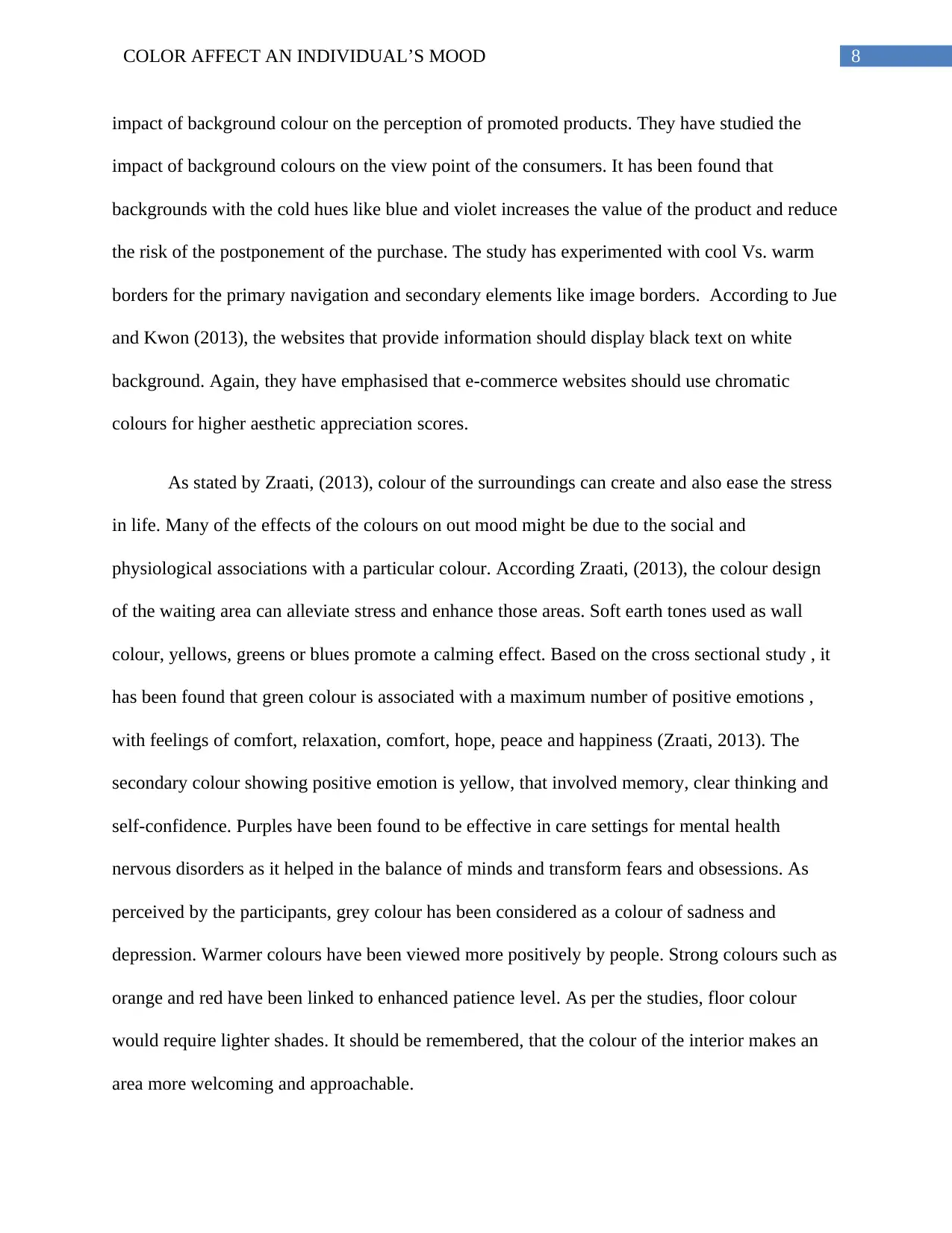
8COLOR AFFECT AN INDIVIDUAL’S MOOD
impact of background colour on the perception of promoted products. They have studied the
impact of background colours on the view point of the consumers. It has been found that
backgrounds with the cold hues like blue and violet increases the value of the product and reduce
the risk of the postponement of the purchase. The study has experimented with cool Vs. warm
borders for the primary navigation and secondary elements like image borders. According to Jue
and Kwon (2013), the websites that provide information should display black text on white
background. Again, they have emphasised that e-commerce websites should use chromatic
colours for higher aesthetic appreciation scores.
As stated by Zraati, (2013), colour of the surroundings can create and also ease the stress
in life. Many of the effects of the colours on out mood might be due to the social and
physiological associations with a particular colour. According Zraati, (2013), the colour design
of the waiting area can alleviate stress and enhance those areas. Soft earth tones used as wall
colour, yellows, greens or blues promote a calming effect. Based on the cross sectional study , it
has been found that green colour is associated with a maximum number of positive emotions ,
with feelings of comfort, relaxation, comfort, hope, peace and happiness (Zraati, 2013). The
secondary colour showing positive emotion is yellow, that involved memory, clear thinking and
self-confidence. Purples have been found to be effective in care settings for mental health
nervous disorders as it helped in the balance of minds and transform fears and obsessions. As
perceived by the participants, grey colour has been considered as a colour of sadness and
depression. Warmer colours have been viewed more positively by people. Strong colours such as
orange and red have been linked to enhanced patience level. As per the studies, floor colour
would require lighter shades. It should be remembered, that the colour of the interior makes an
area more welcoming and approachable.
impact of background colour on the perception of promoted products. They have studied the
impact of background colours on the view point of the consumers. It has been found that
backgrounds with the cold hues like blue and violet increases the value of the product and reduce
the risk of the postponement of the purchase. The study has experimented with cool Vs. warm
borders for the primary navigation and secondary elements like image borders. According to Jue
and Kwon (2013), the websites that provide information should display black text on white
background. Again, they have emphasised that e-commerce websites should use chromatic
colours for higher aesthetic appreciation scores.
As stated by Zraati, (2013), colour of the surroundings can create and also ease the stress
in life. Many of the effects of the colours on out mood might be due to the social and
physiological associations with a particular colour. According Zraati, (2013), the colour design
of the waiting area can alleviate stress and enhance those areas. Soft earth tones used as wall
colour, yellows, greens or blues promote a calming effect. Based on the cross sectional study , it
has been found that green colour is associated with a maximum number of positive emotions ,
with feelings of comfort, relaxation, comfort, hope, peace and happiness (Zraati, 2013). The
secondary colour showing positive emotion is yellow, that involved memory, clear thinking and
self-confidence. Purples have been found to be effective in care settings for mental health
nervous disorders as it helped in the balance of minds and transform fears and obsessions. As
perceived by the participants, grey colour has been considered as a colour of sadness and
depression. Warmer colours have been viewed more positively by people. Strong colours such as
orange and red have been linked to enhanced patience level. As per the studies, floor colour
would require lighter shades. It should be remembered, that the colour of the interior makes an
area more welcoming and approachable.
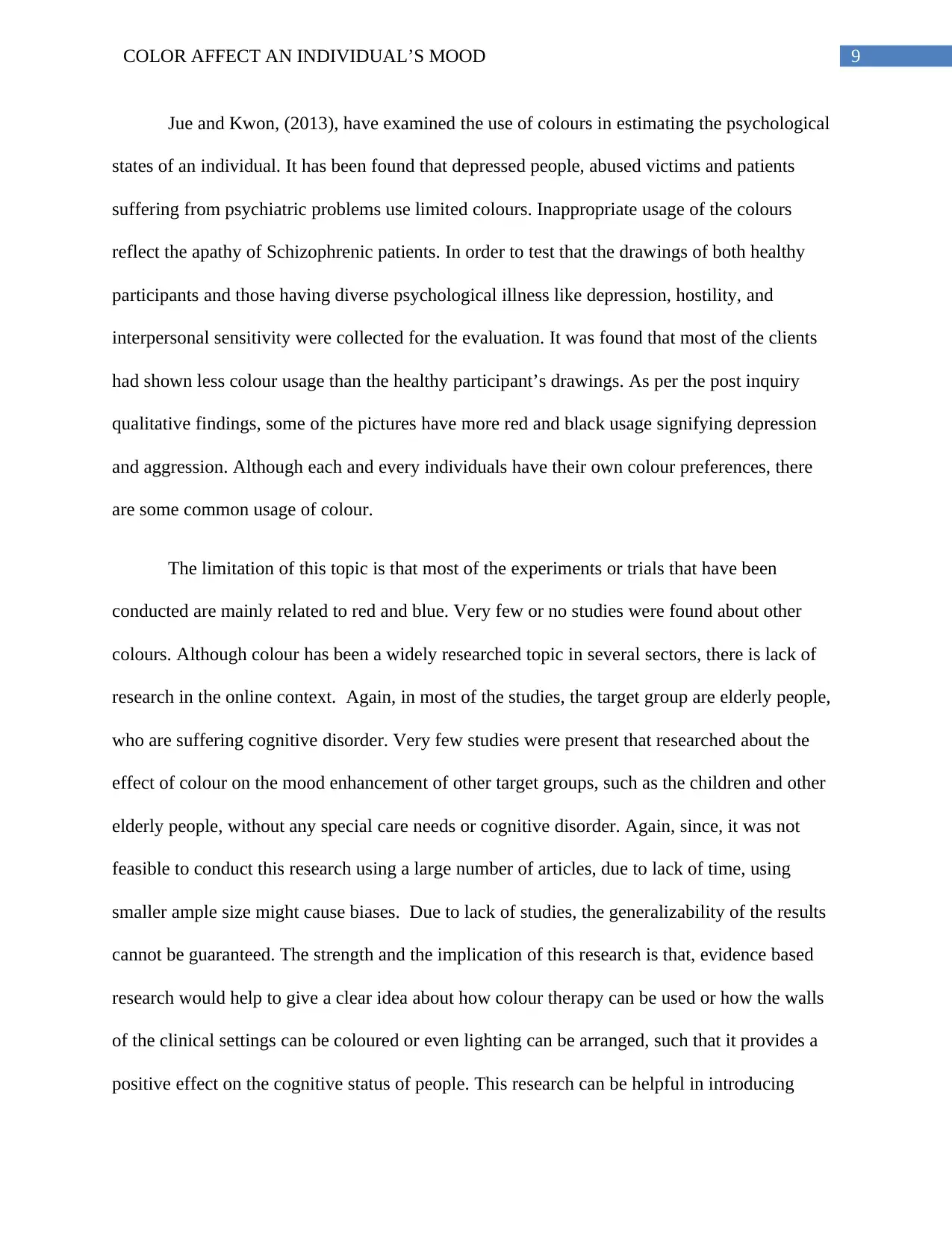
9COLOR AFFECT AN INDIVIDUAL’S MOOD
Jue and Kwon, (2013), have examined the use of colours in estimating the psychological
states of an individual. It has been found that depressed people, abused victims and patients
suffering from psychiatric problems use limited colours. Inappropriate usage of the colours
reflect the apathy of Schizophrenic patients. In order to test that the drawings of both healthy
participants and those having diverse psychological illness like depression, hostility, and
interpersonal sensitivity were collected for the evaluation. It was found that most of the clients
had shown less colour usage than the healthy participant’s drawings. As per the post inquiry
qualitative findings, some of the pictures have more red and black usage signifying depression
and aggression. Although each and every individuals have their own colour preferences, there
are some common usage of colour.
The limitation of this topic is that most of the experiments or trials that have been
conducted are mainly related to red and blue. Very few or no studies were found about other
colours. Although colour has been a widely researched topic in several sectors, there is lack of
research in the online context. Again, in most of the studies, the target group are elderly people,
who are suffering cognitive disorder. Very few studies were present that researched about the
effect of colour on the mood enhancement of other target groups, such as the children and other
elderly people, without any special care needs or cognitive disorder. Again, since, it was not
feasible to conduct this research using a large number of articles, due to lack of time, using
smaller ample size might cause biases. Due to lack of studies, the generalizability of the results
cannot be guaranteed. The strength and the implication of this research is that, evidence based
research would help to give a clear idea about how colour therapy can be used or how the walls
of the clinical settings can be coloured or even lighting can be arranged, such that it provides a
positive effect on the cognitive status of people. This research can be helpful in introducing
Jue and Kwon, (2013), have examined the use of colours in estimating the psychological
states of an individual. It has been found that depressed people, abused victims and patients
suffering from psychiatric problems use limited colours. Inappropriate usage of the colours
reflect the apathy of Schizophrenic patients. In order to test that the drawings of both healthy
participants and those having diverse psychological illness like depression, hostility, and
interpersonal sensitivity were collected for the evaluation. It was found that most of the clients
had shown less colour usage than the healthy participant’s drawings. As per the post inquiry
qualitative findings, some of the pictures have more red and black usage signifying depression
and aggression. Although each and every individuals have their own colour preferences, there
are some common usage of colour.
The limitation of this topic is that most of the experiments or trials that have been
conducted are mainly related to red and blue. Very few or no studies were found about other
colours. Although colour has been a widely researched topic in several sectors, there is lack of
research in the online context. Again, in most of the studies, the target group are elderly people,
who are suffering cognitive disorder. Very few studies were present that researched about the
effect of colour on the mood enhancement of other target groups, such as the children and other
elderly people, without any special care needs or cognitive disorder. Again, since, it was not
feasible to conduct this research using a large number of articles, due to lack of time, using
smaller ample size might cause biases. Due to lack of studies, the generalizability of the results
cannot be guaranteed. The strength and the implication of this research is that, evidence based
research would help to give a clear idea about how colour therapy can be used or how the walls
of the clinical settings can be coloured or even lighting can be arranged, such that it provides a
positive effect on the cognitive status of people. This research can be helpful in introducing
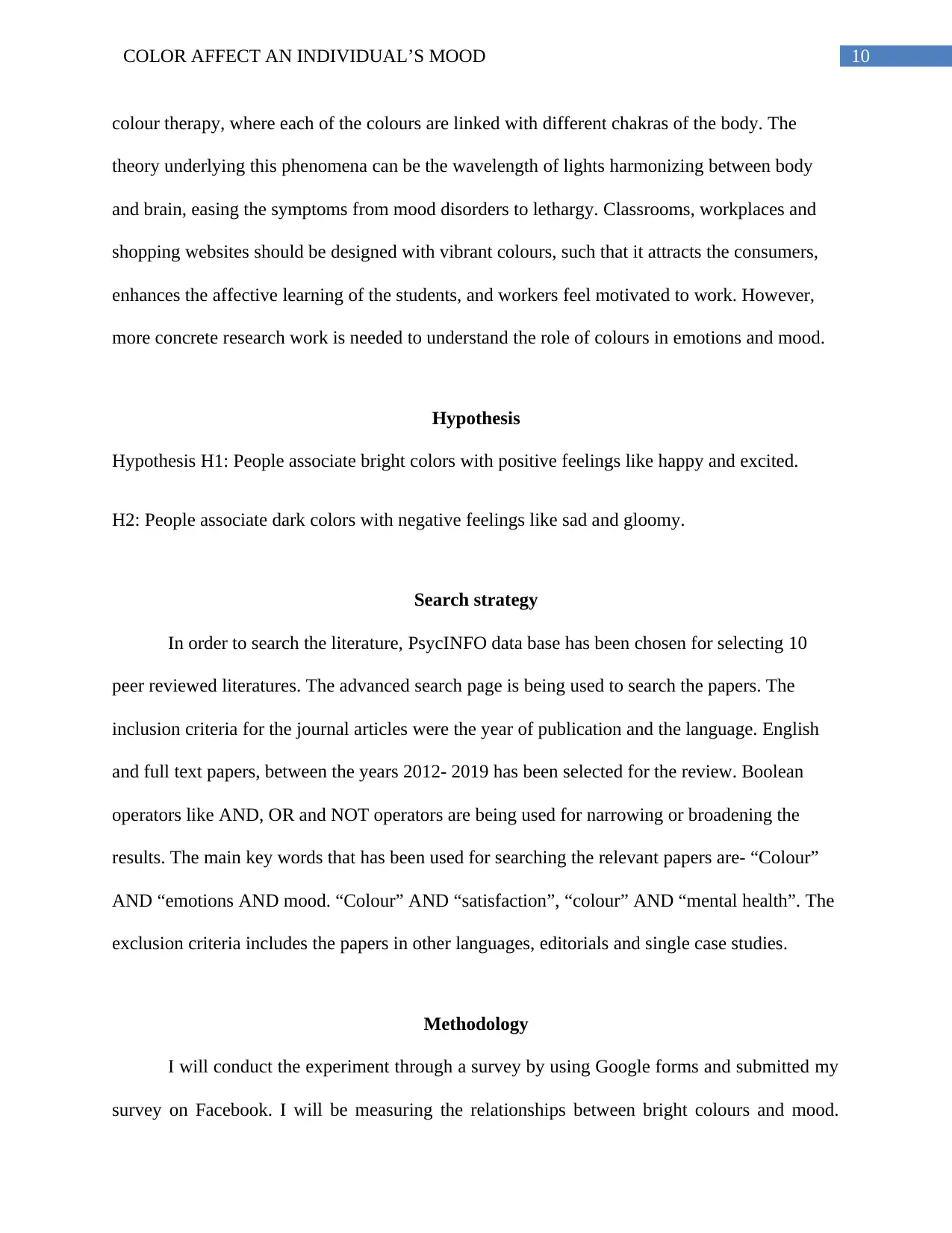
10COLOR AFFECT AN INDIVIDUAL’S MOOD
colour therapy, where each of the colours are linked with different chakras of the body. The
theory underlying this phenomena can be the wavelength of lights harmonizing between body
and brain, easing the symptoms from mood disorders to lethargy. Classrooms, workplaces and
shopping websites should be designed with vibrant colours, such that it attracts the consumers,
enhances the affective learning of the students, and workers feel motivated to work. However,
more concrete research work is needed to understand the role of colours in emotions and mood.
Hypothesis
Hypothesis H1: People associate bright colors with positive feelings like happy and excited.
H2: People associate dark colors with negative feelings like sad and gloomy.
Search strategy
In order to search the literature, PsycINFO data base has been chosen for selecting 10
peer reviewed literatures. The advanced search page is being used to search the papers. The
inclusion criteria for the journal articles were the year of publication and the language. English
and full text papers, between the years 2012- 2019 has been selected for the review. Boolean
operators like AND, OR and NOT operators are being used for narrowing or broadening the
results. The main key words that has been used for searching the relevant papers are- “Colour”
AND “emotions AND mood. “Colour” AND “satisfaction”, “colour” AND “mental health”. The
exclusion criteria includes the papers in other languages, editorials and single case studies.
Methodology
I will conduct the experiment through a survey by using Google forms and submitted my
survey on Facebook. I will be measuring the relationships between bright colours and mood.
colour therapy, where each of the colours are linked with different chakras of the body. The
theory underlying this phenomena can be the wavelength of lights harmonizing between body
and brain, easing the symptoms from mood disorders to lethargy. Classrooms, workplaces and
shopping websites should be designed with vibrant colours, such that it attracts the consumers,
enhances the affective learning of the students, and workers feel motivated to work. However,
more concrete research work is needed to understand the role of colours in emotions and mood.
Hypothesis
Hypothesis H1: People associate bright colors with positive feelings like happy and excited.
H2: People associate dark colors with negative feelings like sad and gloomy.
Search strategy
In order to search the literature, PsycINFO data base has been chosen for selecting 10
peer reviewed literatures. The advanced search page is being used to search the papers. The
inclusion criteria for the journal articles were the year of publication and the language. English
and full text papers, between the years 2012- 2019 has been selected for the review. Boolean
operators like AND, OR and NOT operators are being used for narrowing or broadening the
results. The main key words that has been used for searching the relevant papers are- “Colour”
AND “emotions AND mood. “Colour” AND “satisfaction”, “colour” AND “mental health”. The
exclusion criteria includes the papers in other languages, editorials and single case studies.
Methodology
I will conduct the experiment through a survey by using Google forms and submitted my
survey on Facebook. I will be measuring the relationships between bright colours and mood.
Secure Best Marks with AI Grader
Need help grading? Try our AI Grader for instant feedback on your assignments.
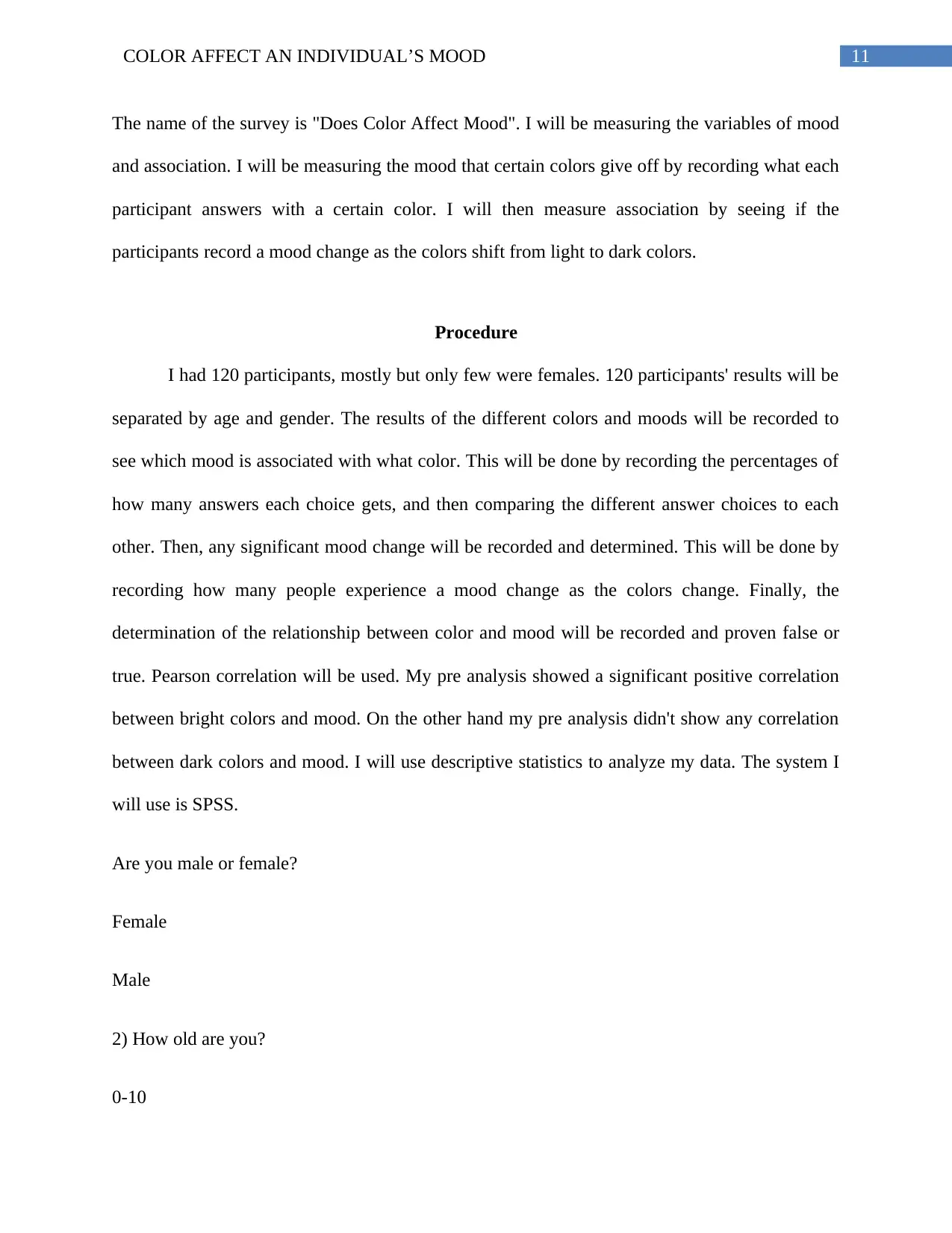
11COLOR AFFECT AN INDIVIDUAL’S MOOD
The name of the survey is "Does Color Affect Mood". I will be measuring the variables of mood
and association. I will be measuring the mood that certain colors give off by recording what each
participant answers with a certain color. I will then measure association by seeing if the
participants record a mood change as the colors shift from light to dark colors.
Procedure
I had 120 participants, mostly but only few were females. 120 participants' results will be
separated by age and gender. The results of the different colors and moods will be recorded to
see which mood is associated with what color. This will be done by recording the percentages of
how many answers each choice gets, and then comparing the different answer choices to each
other. Then, any significant mood change will be recorded and determined. This will be done by
recording how many people experience a mood change as the colors change. Finally, the
determination of the relationship between color and mood will be recorded and proven false or
true. Pearson correlation will be used. My pre analysis showed a significant positive correlation
between bright colors and mood. On the other hand my pre analysis didn't show any correlation
between dark colors and mood. I will use descriptive statistics to analyze my data. The system I
will use is SPSS.
Are you male or female?
Female
Male
2) How old are you?
0-10
The name of the survey is "Does Color Affect Mood". I will be measuring the variables of mood
and association. I will be measuring the mood that certain colors give off by recording what each
participant answers with a certain color. I will then measure association by seeing if the
participants record a mood change as the colors shift from light to dark colors.
Procedure
I had 120 participants, mostly but only few were females. 120 participants' results will be
separated by age and gender. The results of the different colors and moods will be recorded to
see which mood is associated with what color. This will be done by recording the percentages of
how many answers each choice gets, and then comparing the different answer choices to each
other. Then, any significant mood change will be recorded and determined. This will be done by
recording how many people experience a mood change as the colors change. Finally, the
determination of the relationship between color and mood will be recorded and proven false or
true. Pearson correlation will be used. My pre analysis showed a significant positive correlation
between bright colors and mood. On the other hand my pre analysis didn't show any correlation
between dark colors and mood. I will use descriptive statistics to analyze my data. The system I
will use is SPSS.
Are you male or female?
Female
Male
2) How old are you?
0-10
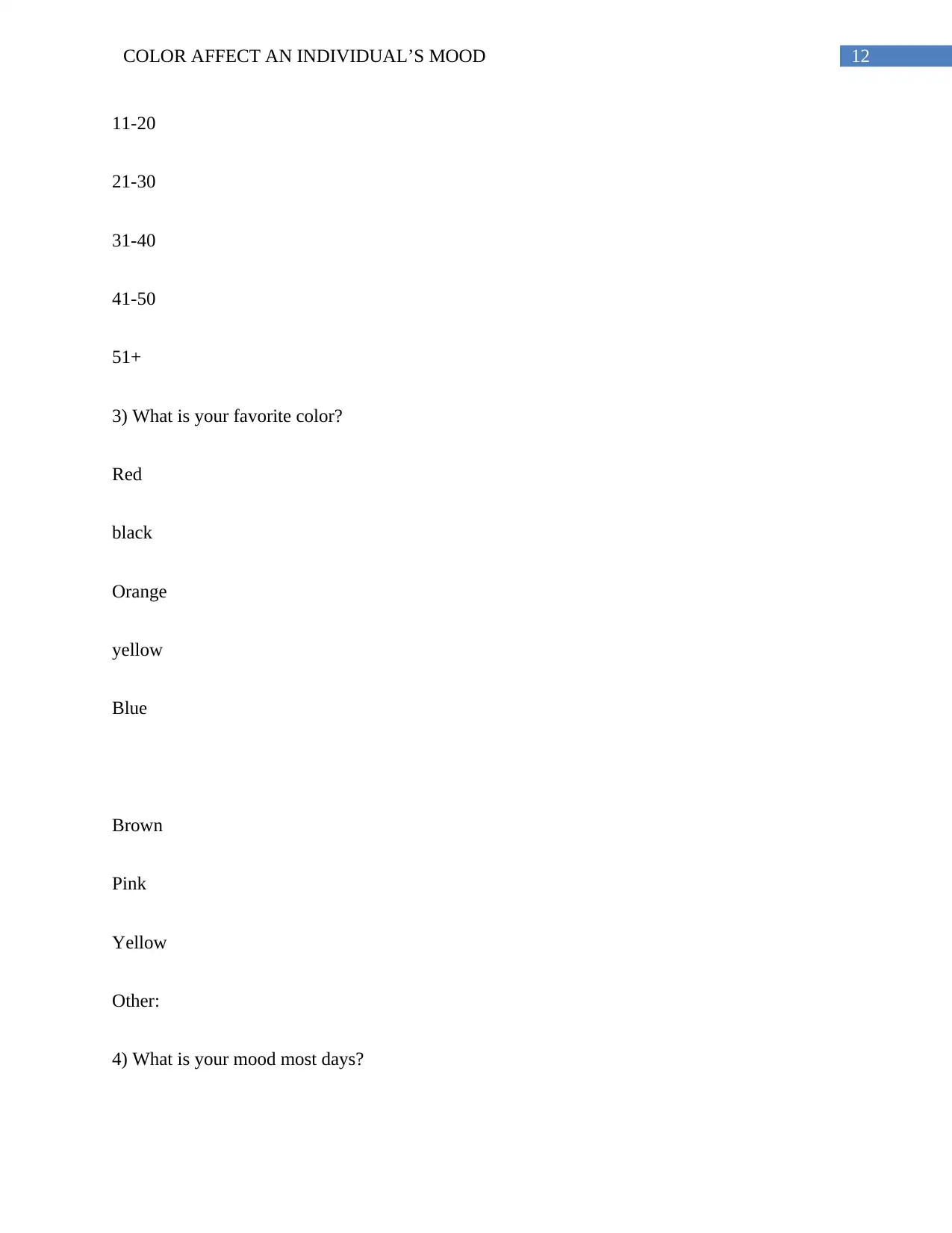
12COLOR AFFECT AN INDIVIDUAL’S MOOD
11-20
21-30
31-40
41-50
51+
3) What is your favorite color?
Red
black
Orange
yellow
Blue
Brown
Pink
Yellow
Other:
4) What is your mood most days?
11-20
21-30
31-40
41-50
51+
3) What is your favorite color?
Red
black
Orange
yellow
Blue
Brown
Pink
Yellow
Other:
4) What is your mood most days?
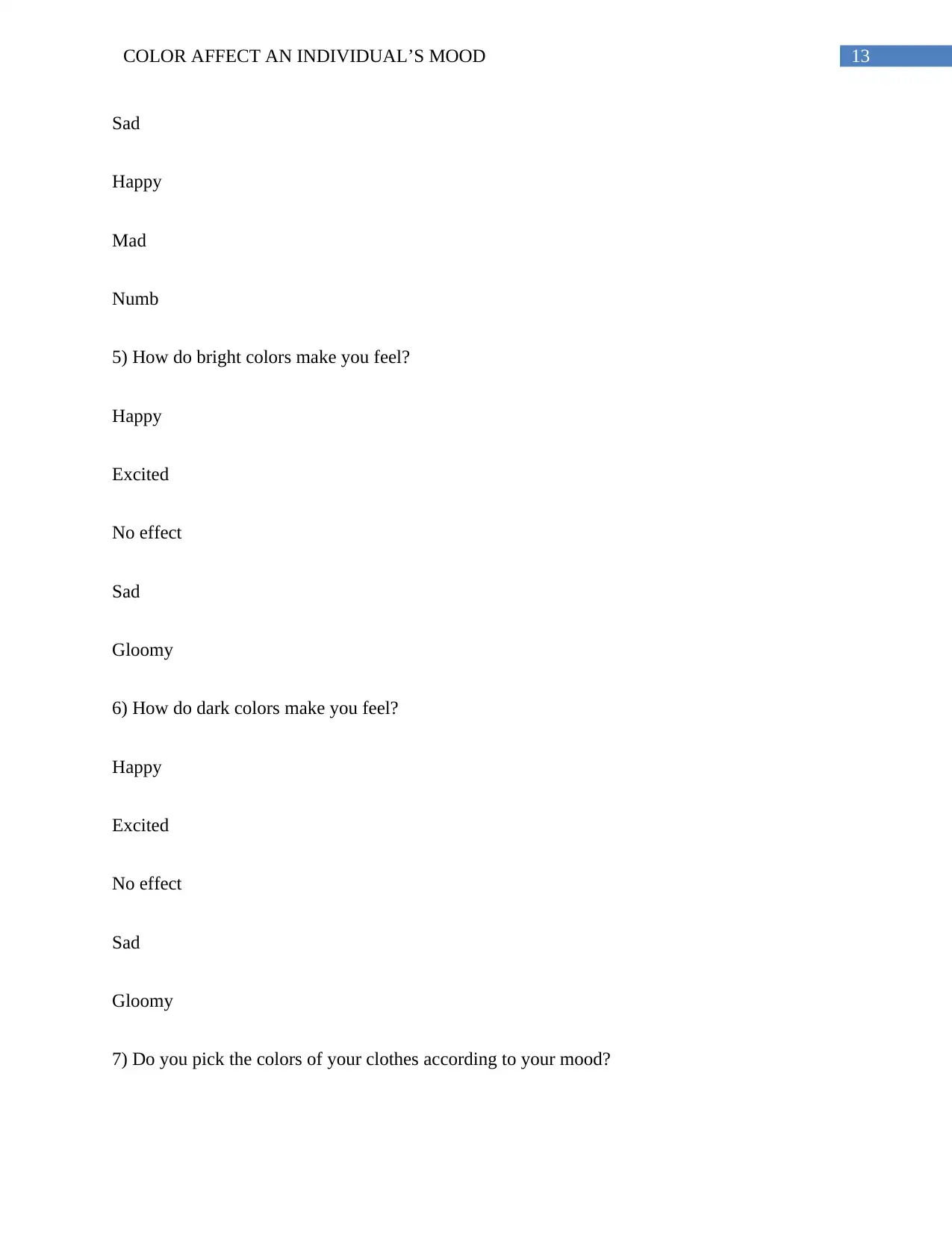
13COLOR AFFECT AN INDIVIDUAL’S MOOD
Sad
Happy
Mad
Numb
5) How do bright colors make you feel?
Happy
Excited
No effect
Sad
Gloomy
6) How do dark colors make you feel?
Happy
Excited
No effect
Sad
Gloomy
7) Do you pick the colors of your clothes according to your mood?
Sad
Happy
Mad
Numb
5) How do bright colors make you feel?
Happy
Excited
No effect
Sad
Gloomy
6) How do dark colors make you feel?
Happy
Excited
No effect
Sad
Gloomy
7) Do you pick the colors of your clothes according to your mood?
Paraphrase This Document
Need a fresh take? Get an instant paraphrase of this document with our AI Paraphraser
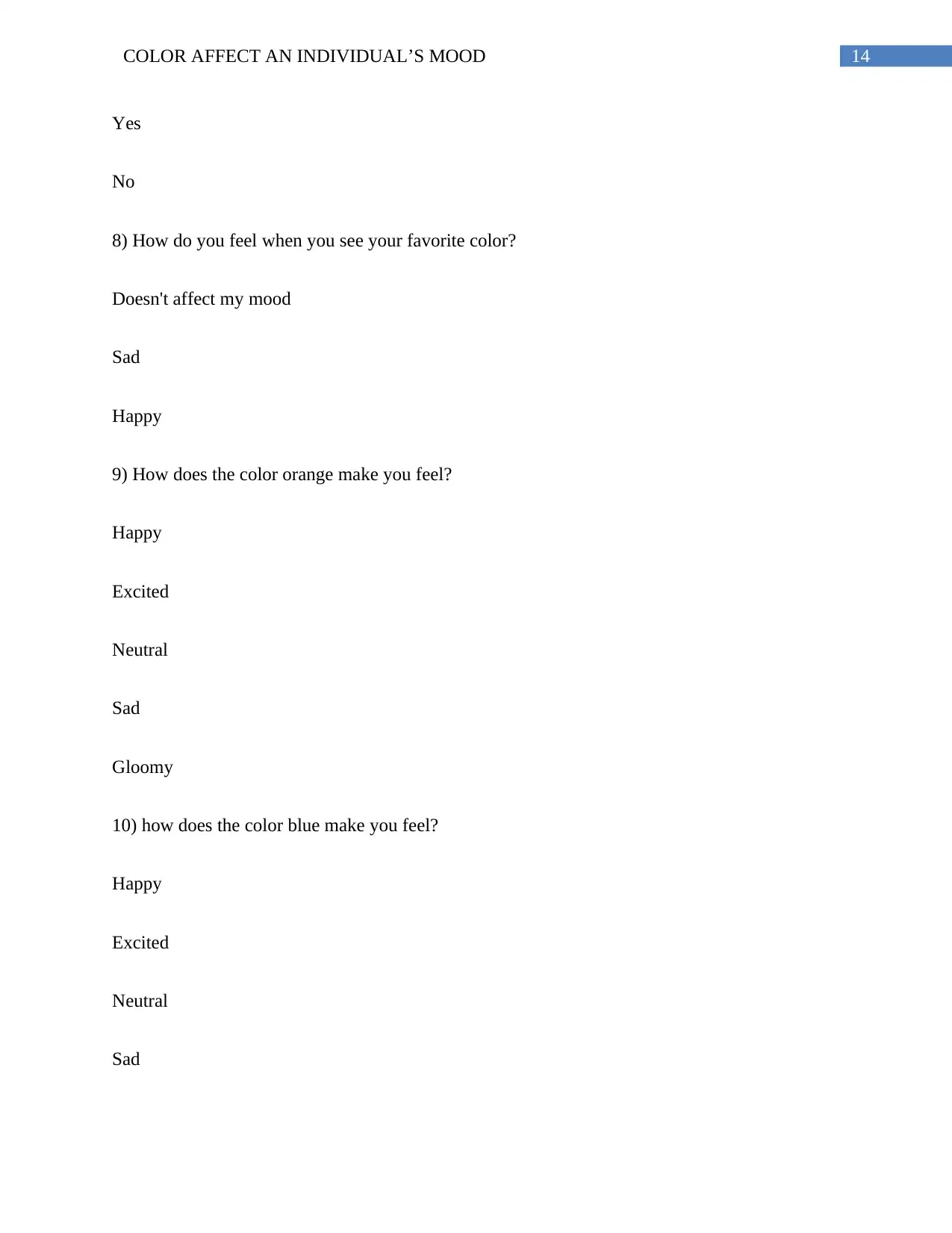
14COLOR AFFECT AN INDIVIDUAL’S MOOD
Yes
No
8) How do you feel when you see your favorite color?
Doesn't affect my mood
Sad
Happy
9) How does the color orange make you feel?
Happy
Excited
Neutral
Sad
Gloomy
10) how does the color blue make you feel?
Happy
Excited
Neutral
Sad
Yes
No
8) How do you feel when you see your favorite color?
Doesn't affect my mood
Sad
Happy
9) How does the color orange make you feel?
Happy
Excited
Neutral
Sad
Gloomy
10) how does the color blue make you feel?
Happy
Excited
Neutral
Sad
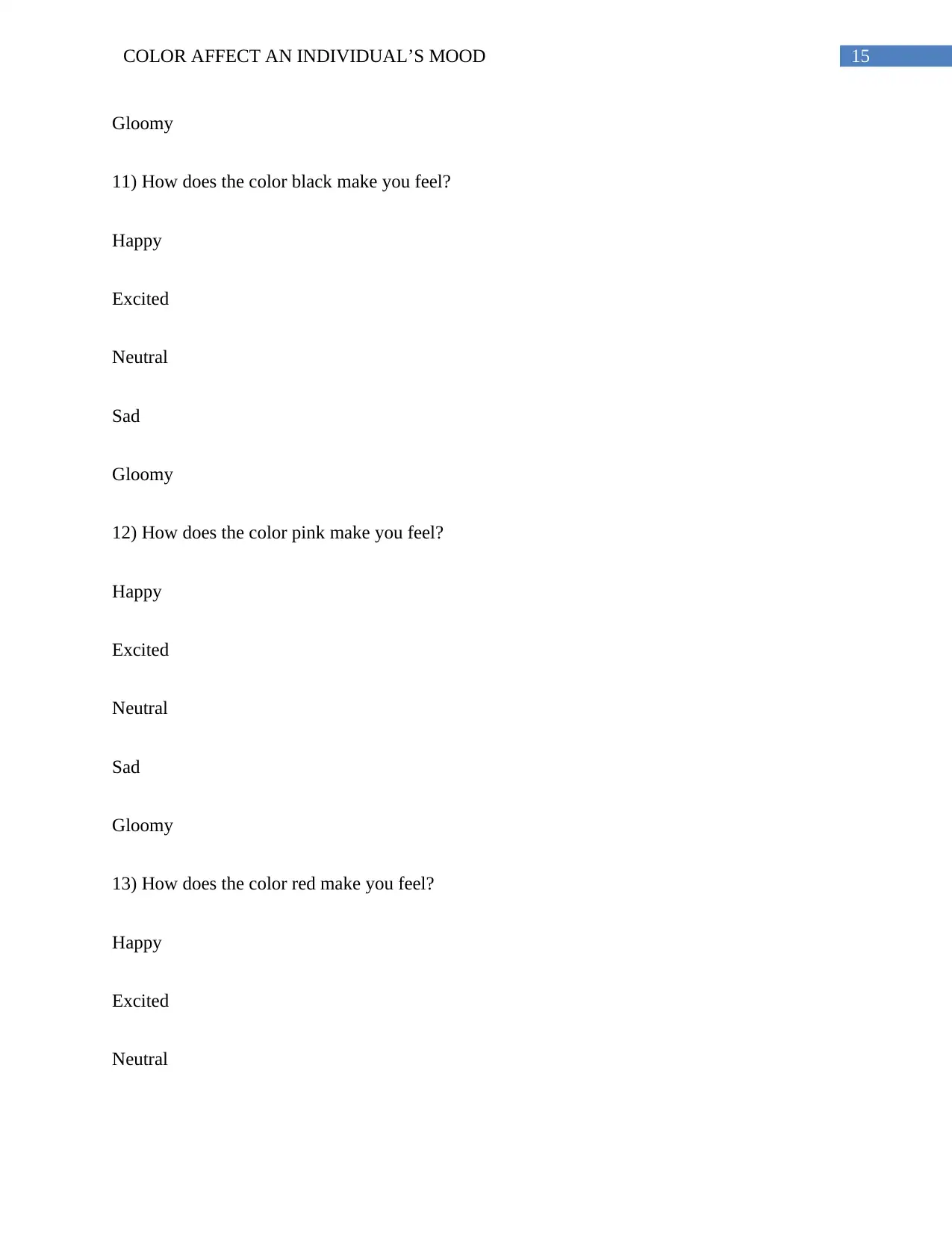
15COLOR AFFECT AN INDIVIDUAL’S MOOD
Gloomy
11) How does the color black make you feel?
Happy
Excited
Neutral
Sad
Gloomy
12) How does the color pink make you feel?
Happy
Excited
Neutral
Sad
Gloomy
13) How does the color red make you feel?
Happy
Excited
Neutral
Gloomy
11) How does the color black make you feel?
Happy
Excited
Neutral
Sad
Gloomy
12) How does the color pink make you feel?
Happy
Excited
Neutral
Sad
Gloomy
13) How does the color red make you feel?
Happy
Excited
Neutral
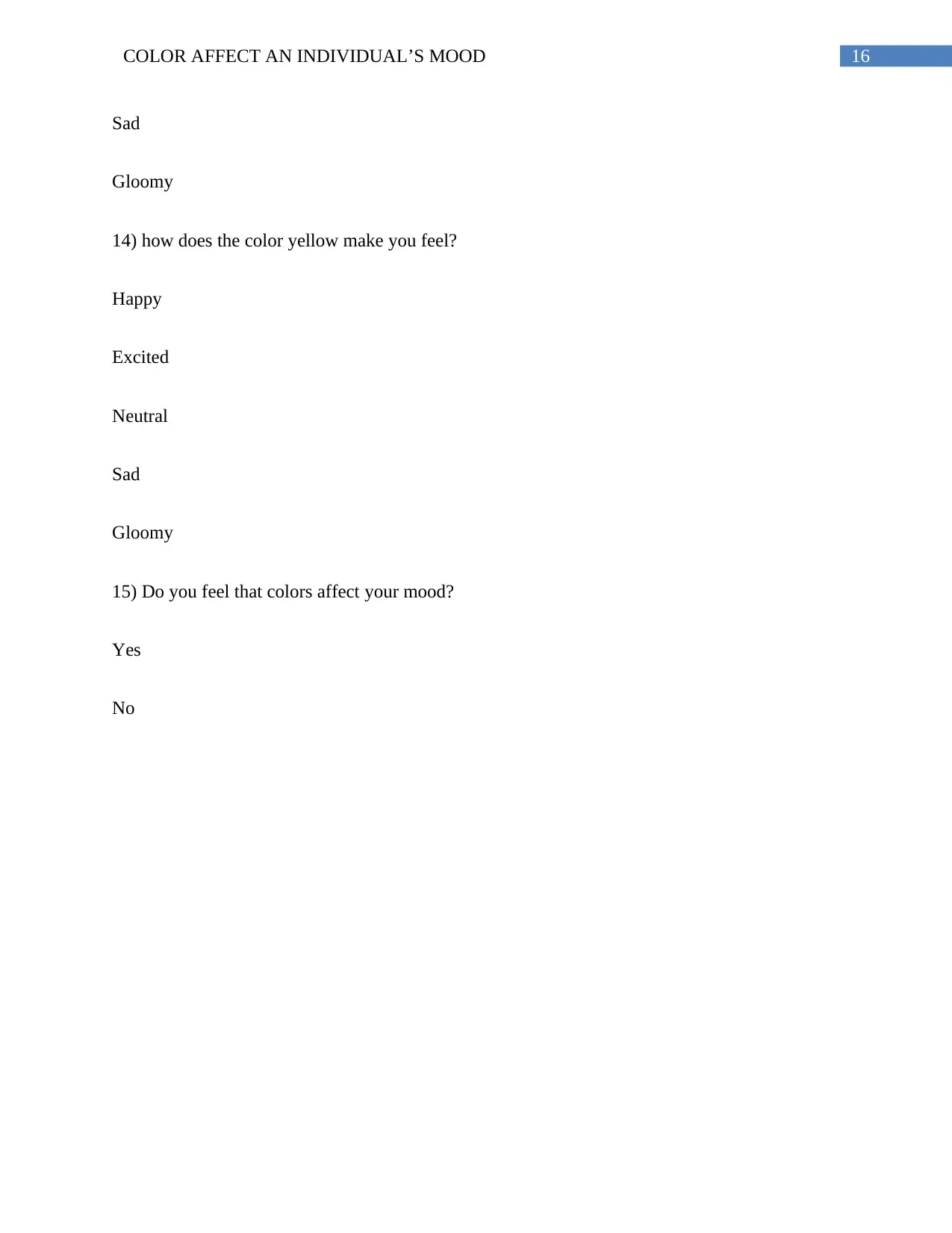
16COLOR AFFECT AN INDIVIDUAL’S MOOD
Sad
Gloomy
14) how does the color yellow make you feel?
Happy
Excited
Neutral
Sad
Gloomy
15) Do you feel that colors affect your mood?
Yes
No
Sad
Gloomy
14) how does the color yellow make you feel?
Happy
Excited
Neutral
Sad
Gloomy
15) Do you feel that colors affect your mood?
Yes
No
Secure Best Marks with AI Grader
Need help grading? Try our AI Grader for instant feedback on your assignments.
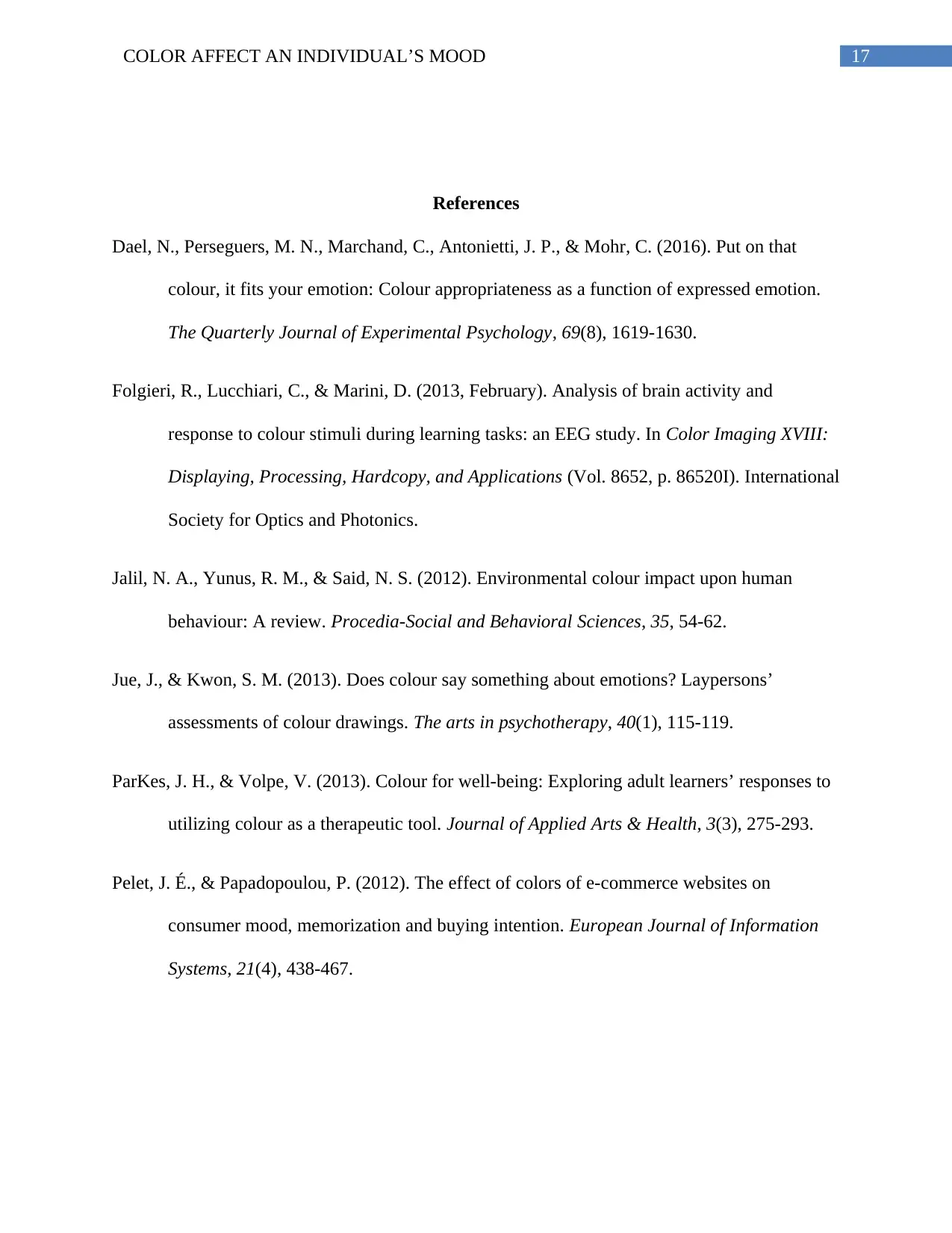
17COLOR AFFECT AN INDIVIDUAL’S MOOD
References
Dael, N., Perseguers, M. N., Marchand, C., Antonietti, J. P., & Mohr, C. (2016). Put on that
colour, it fits your emotion: Colour appropriateness as a function of expressed emotion.
The Quarterly Journal of Experimental Psychology, 69(8), 1619-1630.
Folgieri, R., Lucchiari, C., & Marini, D. (2013, February). Analysis of brain activity and
response to colour stimuli during learning tasks: an EEG study. In Color Imaging XVIII:
Displaying, Processing, Hardcopy, and Applications (Vol. 8652, p. 86520I). International
Society for Optics and Photonics.
Jalil, N. A., Yunus, R. M., & Said, N. S. (2012). Environmental colour impact upon human
behaviour: A review. Procedia-Social and Behavioral Sciences, 35, 54-62.
Jue, J., & Kwon, S. M. (2013). Does colour say something about emotions? Laypersons’
assessments of colour drawings. The arts in psychotherapy, 40(1), 115-119.
ParKes, J. H., & Volpe, V. (2013). Colour for well-being: Exploring adult learners’ responses to
utilizing colour as a therapeutic tool. Journal of Applied Arts & Health, 3(3), 275-293.
Pelet, J. É., & Papadopoulou, P. (2012). The effect of colors of e-commerce websites on
consumer mood, memorization and buying intention. European Journal of Information
Systems, 21(4), 438-467.
References
Dael, N., Perseguers, M. N., Marchand, C., Antonietti, J. P., & Mohr, C. (2016). Put on that
colour, it fits your emotion: Colour appropriateness as a function of expressed emotion.
The Quarterly Journal of Experimental Psychology, 69(8), 1619-1630.
Folgieri, R., Lucchiari, C., & Marini, D. (2013, February). Analysis of brain activity and
response to colour stimuli during learning tasks: an EEG study. In Color Imaging XVIII:
Displaying, Processing, Hardcopy, and Applications (Vol. 8652, p. 86520I). International
Society for Optics and Photonics.
Jalil, N. A., Yunus, R. M., & Said, N. S. (2012). Environmental colour impact upon human
behaviour: A review. Procedia-Social and Behavioral Sciences, 35, 54-62.
Jue, J., & Kwon, S. M. (2013). Does colour say something about emotions? Laypersons’
assessments of colour drawings. The arts in psychotherapy, 40(1), 115-119.
ParKes, J. H., & Volpe, V. (2013). Colour for well-being: Exploring adult learners’ responses to
utilizing colour as a therapeutic tool. Journal of Applied Arts & Health, 3(3), 275-293.
Pelet, J. É., & Papadopoulou, P. (2012). The effect of colors of e-commerce websites on
consumer mood, memorization and buying intention. European Journal of Information
Systems, 21(4), 438-467.
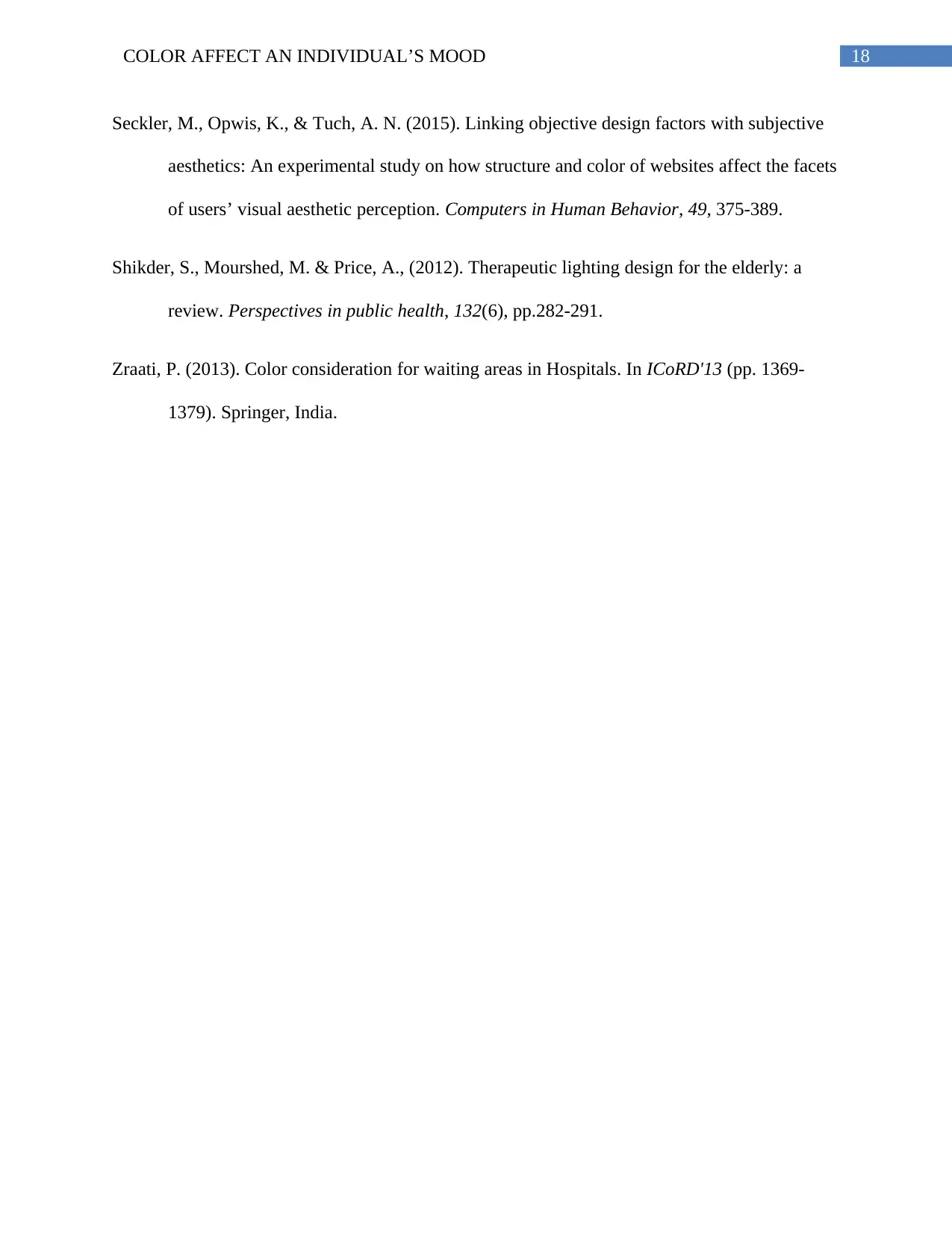
18COLOR AFFECT AN INDIVIDUAL’S MOOD
Seckler, M., Opwis, K., & Tuch, A. N. (2015). Linking objective design factors with subjective
aesthetics: An experimental study on how structure and color of websites affect the facets
of users’ visual aesthetic perception. Computers in Human Behavior, 49, 375-389.
Shikder, S., Mourshed, M. & Price, A., (2012). Therapeutic lighting design for the elderly: a
review. Perspectives in public health, 132(6), pp.282-291.
Zraati, P. (2013). Color consideration for waiting areas in Hospitals. In ICoRD'13 (pp. 1369-
1379). Springer, India.
Seckler, M., Opwis, K., & Tuch, A. N. (2015). Linking objective design factors with subjective
aesthetics: An experimental study on how structure and color of websites affect the facets
of users’ visual aesthetic perception. Computers in Human Behavior, 49, 375-389.
Shikder, S., Mourshed, M. & Price, A., (2012). Therapeutic lighting design for the elderly: a
review. Perspectives in public health, 132(6), pp.282-291.
Zraati, P. (2013). Color consideration for waiting areas in Hospitals. In ICoRD'13 (pp. 1369-
1379). Springer, India.
1 out of 18
Your All-in-One AI-Powered Toolkit for Academic Success.
+13062052269
info@desklib.com
Available 24*7 on WhatsApp / Email
![[object Object]](/_next/static/media/star-bottom.7253800d.svg)
Unlock your academic potential
© 2024 | Zucol Services PVT LTD | All rights reserved.


